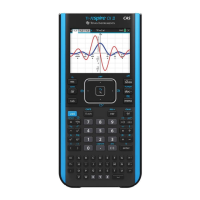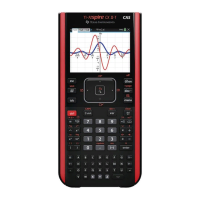The number of opening and closing parentheses, brackets, and braces must be the
same within an expression or equation. If not, an error message is displayed that
indicates the missing element. For example, (1+2)/(3+4 will display the error message
“Missing ).”
Note: Because the TI-Nspire™CAS software allows you to define your own functions, a
variable name followed by an expression in parentheses is considered a “function call”
instead of implied multiplication. For example a(b+c) is the function a evaluated by
b+c. To multiply the expression b+c by the variable a, use explicit multiplication: a•
(b+c).
Indirection
The indirection operator (#) converts a string to a variable or function name. For
example, #(“x”&”y”&”z”) creates the variable name xyz. Indirection also allows the
creation and modification of variables from inside a program. For example, if 10→r
and “r”→s1, then #s1=10.
Post Operators
Post operators are operators that come directly after an argument, such as 5!, 25%, or
60°15' 45". Arguments followed by a post operator are evaluated at the fourth priority
level. For example, in the expression 4^3!, 3! is evaluated first. The result, 6, then
becomes the exponent of 4 to yield 4096.
Exponentiation
Exponentiation (^) and element-by-element exponentiation (.^) are evaluated from
right to left. For example, the expression 2^3^2 is evaluated the same as 2^(3^2) to
produce 512. This is different from (2^3)^2, which is 64.
Negation
To enter a negative number, press v followed by the number. Post operations and
exponentiation are performed before negation. For example, the result of −x
2
is a
negative number, and −9
2
= −81. Use parentheses to square a negative number such
as (−9)
2
to produce 81.
Constraint (“|”)
The argument following the constraint (“|”) operator provides a set of constraints that
affect the evaluation of the argument preceding the operator.
EOS™ (Equation Operating System) Hierarchy 237

